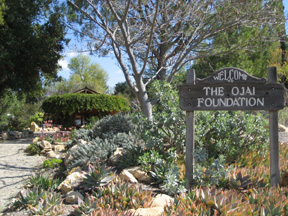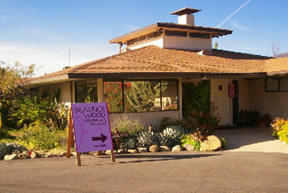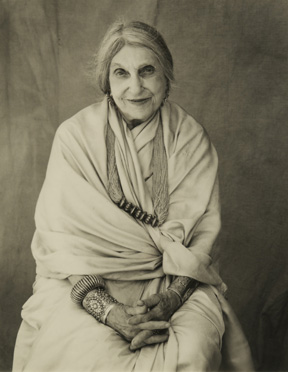 |
|


(clockwise from top) Liam O'Gallagher,
Sunny Rudolph (with the famous dog
Corey), VJ Supera, Robert Rheem,
India Supera (center) gathered after
the Summer Solstice Celebration at
Feathered Pipe Ranch, 1973.
Photo by William Gray Harris |
by India Supera
In June of 1972, I came home from India, having lived there for many years. I had met Jermaine (Jerry) Duncan and her husband David Graham at Sri Baba's ashram. Through them I met Liam and Bob. They were all futurists and interested in new thought. They thought it would be great to create a place where people could gather for creative thought - a sort of manifestation tank. Jerry had some money through her family and was able to buy the Rheem ranch, which featured acres of trees and Adirondack-style cabins. It became Jerry's dream and Bob and Liam stayed in Montana to help her realize it.
The Rheems had made it such a beautiful place, which was important to its success. They originally called it Bearcreek Lodge, though people to this day refer to it as the old Rheem lodge. It backs up to hundreds of acres of state forest. I met the Rheems late in their lives, but felt they were so happy to have Liam and Bob in their life. They were aware that Liam and Bob knew so many people and an important part of the art world. Liam and Bob came up with the name, which was based on a pipe that was used for direction by Native Americans. They would suspend the feather[ed] pipe from a tree and go to sleep and in the morning go the direction the pipe was pointing. They believed people would come to find direction in life.
|
Bob has a level of aesthetics that very few people have – he would create beautiful gardens and cook dinner every night and Bob and Liam created this energy. He and Liam would meet people at the bus station and bring them home… they had a great sense of people and brought in those who were right for the place. They would have these wonderful dinners for everyone, they prepared the meals and the atmosphere was a wonderful soiree every night. I've studied with a lot of yogis in India and very few had what Liam had. In his company, we would transcend and the entire experience would be raised. Liam had an incredible amount of not only literary and intellectual being but he had this great heart and crystal clear mind. It was an incredible experience for me, being 24 years and just coming back from India, which was the equivalent of my college education. This was my first experience of intelligent, forward thinking people.
At the end of the summer, we decided we were going to go to Arizona and Jerry was going to buy a place there, so that we would have year round events – in Montana in the summer and Arizona in the winter. But then, Jerry developed cancer and within a year was gone. She left me the ranch, believing I could carry on the vision, but I was at loose ends and didn't know what to do. I thought I should just sell the place. Liam was a real guiding light – I was so much younger and less educated than he and Bob and looked to them for help. Liam told me that I had to make it into something, saying that I was selected for the job by something higher than myself. I went back to talk to Sai Baba, who told me, "You can do what you can do, find out what it is and do that." And so I set off to do make something out of Feathered Pipe Ranch.
Liam and Bob would come back every summer and encourage me and soon others joined in. Without Liam O' Gallagher, Feather[ed] Pipe Ranch wouldn't be here today. He would continue to encourage me saying, "that's a good start".” At first we put up tents and teepees and then later divided the bedrooms in the main lodge into dorms. They would suggest people like Joan Halifax and Joseph Campbell to come, which opened up the world of people who could be part of it and brought it to life. Liam didn't have an attachment to the outcome. His interest was in helping to make it happen. He connected people, who were connected with others and he was like a stone dropped in a pond. Feathered Pipe Ranch ultimately became an important part of the growth of yoga in the West and because of Liam almost every yoga student in the country has been touched or benefited in some way.
-India Supera |


The Ojai Foundation |
Happy Valley had always been much more than a place. It is a dream, entrusted to those who have envisioned its role in human development and have taken on the work of bringing it to fruition. Just as the Chumash people considered the site a sacred place, in 1927, an elderly Annie Besant had a vision upon seeing the valley for the first time, which led her to arrange for its purchase. Since that time, numerous others have sustained this vision. In 1946, the Happy Valley School (now the Besant Hill School) was opened and Rosalind Rajagopal, who had been by Annie Besant’s side when she’d had her vision of the valley’s future, dedicated the rest of her life to its success.
|
“I met Liam O'Gallagher in the early 1970s, at the home of Beatrice Wood,” recalls Susan Clark. “It was immediately clear to me that Liam, and his life partner Bob Rheem, were highly creative, insightful, and cared deeply about the goals and vision of Happy Valley. Liam was also a visionary and could see potential in people, places, and things.”
Liam had been discussing the blending of spirit and science with a friend Lucio “Luke” Gatto, and the possibility of doing something at Happy Valley. Soon a team was formed, combining Luke's science background, Liam's vision and ideas, and Susan Clark’s analytical and administrative skills. Several young physicists, including Fritzof Capra and Jack Sarfati, as well as biologists and others were invited to visit Ojai and see if they liked the idea of being on sabbatical in a pristine, natural environment. High Winds, a property adjacent to Happy Valley, was rented, and a small organization began. Joan Rindge, of The Human Dimensions Institute, was contacted, and she agreed for them to establish The Human Dimensions Institute West in Ojai. Liam kept Rosalind up-to-date on the progress of the project, and wrote a letter to the Trustees of the Happy Valley Foundation, describing how it was in line with the vision Annie Besant had in originally purchasing the land:
“It seems to me and I’m sure it must to you that there is a need at this time in order to go forward with the development of our community, to clarify and emphasize the ideas and purposes of our founder Dr. Annie Besant. Aside from those that are clearly stated in the articles of Incorporation, there are in print a few statements and also her Declaration of Trust. She was, as you must know, a most remarkable person, completely selfless, devoting her whole life to the welfare of others. A few of us still alive who knew her can state whatever it is we remember that she said. I for one remember that she often said that it was for the new generation that she acquired Happy Valley and although she would leave its development to the future she was certain that the new generation defining and redefining the thoughts and ideals that contributed to its founding would discover new ways to implement the goals of the Foundation with imagination and diversity. She most certainly was opposed to dogmatic acceptance of a single cult, view, program or personality. Openmindness, exploration and cooperation were the qualities she insisted would best guide the functioning of the Happy Valley Foundation, The Future, which is NOW, was her main concern and it was for a new community she set aside this land. She anticipated the evolutionary crossroad we have reached and she saw the need for new models of community where human beings could identify with the evolution beyond the present stage. Her philosophy of education was always based on brotherhood, non-sectarianism and the unity of life. She was aware of the crises in consciousness that would arise in our age and insisted on cooperation and interaction in all that takes place in the Happy Valley Community. She cared for life in all its forms. The new physics, biology and psychology that cooperate with the evolution and do most to release the human potential for the new civilization, she would have lauded, and she would have responded to the new ecological architecture that uses solar energy. Education of the complete man was always her goal. A planning committee has been established to aid in the developing of new projects within the community based on these ideas, and it shall be our policy that it will be the duty of all persons who would share in this endeavor to agree with a policy that preserves the Foundation created by so great an ideal and for so noble a purpose.”
“Rosalind was remarkable in her ability to be both visionary and practical,” Susan recalls. “She was enthusiastic about our ideas and offered us 40 acres of Happy Valley Land.”
As plans progressed, the inevitable problems arose, and Liam worked to balance the personalities involved, and the larger vision.
“Luke Gatto was instrumental in the beginning, but eventually resigned,” Bob recalls. “Liam decided that Joan Halifax, who at the time was working for Joseph Campbell, would be the ideal person to head up the organization.”
Liam and Bob traveled to New York to see Joan and asked if she was interested in coming out and seeing the place. Campbell was just finishing up the book she was assisting him with, so she came out and agreed to take up the reins of what became the Ojai Foundation.
“I met Liam in the mid 1970s,” Roshi Joan Halifax recalls. “Clearly he was an artist and visionary and I was very attracted to spend time with him and his good friend Bob Rheem. Liam was brave, amusing, wonderfully alive to the natural world, had an extraordinary aesthetic, and was utterly kind and intelligent. He drew me onto the Ojai land with the sense that there was something that I could do there that might make a difference. It was his faith in me that made it possible for me to leave my work with mythologist Joseph Campbell and bring alive the mythic, Buddhist, and visionary dimension that Liam and I shared.”
Under the direction of Joan Halifax, the newly named Ojai Foundation at Happy Valley experienced dramatic growth. Within the first few years, it welcomed teachers from wide-ranging traditions, including Thich Nhat Hanh, Trungpa Rinpoche, Zen Master Seung Sahn, Wallace Black Elk, Tomas Banyaca of the Hopi Nation, and many others. Having fulfilled his mission, Liam remained for a time on the Board of Advisors, but ultimately decided that, as he had accomplished his goals, the Foundation had taken on a life of its own. It was time to move on. |


The Beatrice Wood Center for the Arts

Beatrice Wood
photo by Tony Cunha
|
Beatrice Wood’s dream was that one day her home in Happy Valley might be transformed into a cultural center. Toward this end, Rosalind’s daughter, Radha Rajagopal Sloss, spearheaded the creation of the Happy Valley Cultural Center in 2000. When Liam and Bob became aware of these plans, they donated works they had purchased from Wood years before to assist with the funding. Initially, the Center existed largely in concept, as an organization to sponsor performances and lectures in Happy Valley.
In 2005, a decision was made to transform the homes of Beatrice Wood and Rosalind Rajagopal into the Beatrice Wood Center for the Arts, to bring the Cultural Center to life. Looking after the legacies of their good friends, Liam and Bob were instrumental in the creation of the Center. For Liam, the Beatrice Wood Center for the Arts, like the Feathered Pipe Ranch and Ojai Foundation, was a means of bringing people together to explore creative thought. Rather than yoga, science, or philosophy, the Center looked to art as a means of expanding consciousness. It was a means of human transformation that Liam had turned to repeatedly throughout his life.
Nearing the age of 90, Liam made clear his wish that all of his paintings and intellectual property be given to the Beatrice Wood Center for the Arts, to raise funds for its success. Today the Center houses Liam’s archives, which include works of art, numerous notebooks filled with his poetry, ideas and philosophy, correspondence with legendary artists and poets, and enough material to fill a dozen books. |
|
|
 |
|